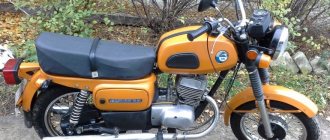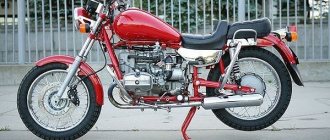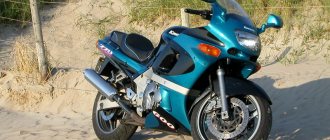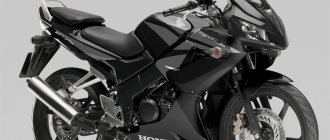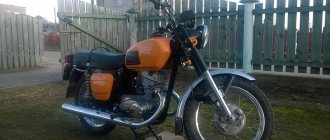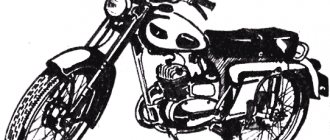In Soviet times, there were many attempts to use captured drawings of German equipment to create a high-quality and inexpensive domestic motorcycle. But there were also cases when engineers, having sufficient experience and knowledge, tried to create something of their own, only relying on technologies that were obtained from outside. Such attempts were not always successful, but some of them managed to survive the “time of troubles” and their “descendants” are still being produced.
“Voskhod” is a trademark owned by the Degtyarev Plant (ZiD). Production began with the release of equipment that replicated the development of the Kovrov plant. The K-175 model, taken as a basis, was mass-produced in the period from 57 to 65.
Main characteristics of Voskhod 3 M
The technical characteristics of the “Voskhod Z M” are pleasantly pleasing, allowing you to take walks both on the highway and on country roads.
Length of base from wheel to wheel, 1.3 meters
| External dimensions (length/width/height), meters | 2,0/0,76/1,09 | ||||||||||||||||||||||||||||||
| Dry weight, kilograms | 122 | Engine | One cylinder for two strokes, capacity 173 cm3 | Cooling system | Air | Power on offer at 5600 rpm | 15 horsepower | Torque at 5200 rpm | Reaches 16 Nm | Speed maximum | 110 kilometers per hour | Fuel consumption, liters | 4.2 per hundred kilometers | Generator | 12 volts | Front suspension | Telescope fork, stroke—1.6 cm | Rear suspension | The pendulum at an angle of 20 degrees gave a stroke of 8.5 cm | Brake mechanism | The drums, with a diameter of 16 centimeters, had an indicator of block production | Clearance | 12.5 centimeters | Load limit | 160 kilograms | Fuel tank volume | 14 liters | checkpoint | Four-speed | Wheels | Spoked, tube tires, 16 inches |
Characteristics of the Voskhod motorcycle
The history of Voskhod motorcycles goes back to 1946. Then the Kovrov plant launched production of the first K-125 motorcycles. Already in 1957, the produced models were replenished with the new K-175, with an engine capacity increased by 50 cubic centimeters. The plant's products were regularly modernized; Kovrovets-175A, Kovrovets-175B, and Kovrovets-175V were developed and produced. After this came the era of the Sunrises. First, just “Voskhod” (beginning of production in 1965), then “Voskhod-2 and 2M”, “Voskhod 3, 3M, 3M Tourist and 3M-01”. Subsequent models were named “Owl” and “Courier”. Of the entire model range, the most famous are “Voskhod-2” and “Voskhod-3M”; we will get acquainted with their technical characteristics in more detail.
Voskhod-2 received an improved, more reliable engine compared to earlier models. Its power also increased, albeit slightly. Most of the parts were unified; they easily fit older models. The carburetor is covered with a special casing. The suspension elements were also modernized. The quality of the front and rear shock absorbers has improved, which also affects the comfort of the driver and passenger. The behavior of the motorcycle on the road has changed, now it is more stable and predictable.
The front fork is not interchangeable with older models; if there is a need to install a front fork on Kovrovets, this can only be done assembled with casings and traverses. The steering wheel is attached to the fork with pads that prevent breakage (in older models it was attached using clamps). In addition, it is now taller and closer to the saddle. However, more changes affected the decorative elements and appearance of the motorcycle. For example, the trunk on a motorcycle is integral with the seat base. They are even made by stamping from a single blank. The motorcycle was produced until 1977, after which it was replaced by a more advanced model.
| Technical characteristics of the motorcycle Voskhod - 2 | |
| Engine | Push-pull |
| Cylinder displacement | 173.7 cm3 |
| Cooling | Air |
| Torque | 1.5 Kgm at 4000 rpm. |
| Cylinder diameter | 61.75 mm |
| Piston stroke | 58 mm |
| Maximum power | 10.5-11.5 hp at 5400 |
| Highest speed | 95-100 km.hour |
| Acceleration time to 60 km/h | 8 seconds |
| Gas tank capacity | 13 liters |
| Fuel consumption at a speed of 50 km/h, l/100 km | 2.8 liters |
| Carburetor | K-36 |
| Weight | 112 kg. |
| Tires | 3,25—16? |
| Braking distance at a speed of 30 km/h | No more than 7.2 meters |
From 1983 to 1993, the Voskhod-3M model was produced. The changes affected almost all components and parts of the motorcycle. A needle bearing was installed in the upper head of the connecting rod, and the engine cylinder has enlarged ribs for better cooling.
The front shock absorbers are equipped with corrugated rubber covers (previous models had metal covers), now they protect much better from dirt and dust. The new steering wheel provides a wide range of adjustments; drivers of different heights will have no difficulty in choosing it individually to suit their dimensions. The brakes are equipped with special indicators, thanks to which you can easily monitor the condition of the brake linings.
The electrical equipment of the motorcycle has undergone serious modernization. He received a new generator with a capacity of 65 watts alternating current, 12 volts. The transition to 12-volt electrical equipment made it possible to use improved lighting devices and also make it easier to start the engine. Headlight FG-137B with a new lens. Above the headlight is the instrument panel, which combines the speedometer, warning lamps and ignition switch. The brake light is activated by both the foot and hand brakes. All electrical connections are made using plugs.
And of course, the appearance of the motorcycle has been transformed thanks to new cladding parts, such as the front wheel guard, rear-view mirrors, etc.
| Technical characteristics of the Voskhod - 3M motorcycle | |
| Engine | Push-pull |
| Cylinder displacement | 173.7 cm3 |
| Cooling | Air |
| Compression ratio | 9,5 |
| Cylinder diameter | 61.72 mm |
| Piston stroke | 58 mm |
| Maximum power | 14 hp at 5500-5800 |
| Highest speed | 105 km.hour |
| Ignition | Electronic, contactless |
| Gas tank capacity | 14 liters |
| Height | 1090 mm |
| Length | 2000 mm |
| Width | 730 mm |
| Tires | 3,25—16? |
| Braking distance at a speed of 60 km/h | 20 meters |
A little magic
Although it is difficult to turn the Voskhod bike, even with the most modern tuning, into something more modern and super-powerful, nevertheless, true fans of the series still do not lose hope and tune each one in their own way. In numerous photos of “Voskhod 3 M” you can see the following modification options:
- closer to the “sport” class:
- raising the rear shock absorbers;
- change the exhaust elbow, moving it a little higher and replace the pipe diameter with a larger one;
- allows you to increase power;
- a variation of the “chopper” can be seen in the video “Voskhod 3 M”:
- the rear is lowered, the fork and wheel are replaced with wide options;
- change the angle of the front fork;
- cylinder covers are dressed in chrome;
- change the steering wheel to a “Chopper” one, and also do not forget about the instrument panel, headlights and tires;
- changing the air filter to foam elements gives the engine a boost;
- Don't forget about aerodynamics.
Intermediate stage between Voskhod-3M and the new ZDK family
Motorcycle Voskhod-3M-01
I think it’s no secret that putting a completely new model on the production line is quite a complicated matter. As a rule, it is necessary to purchase and install new equipment and reconstruct old production. It’s labor-intensive, expensive, and you also have to follow the plan. That is why most motorcycle and automobile factories are switching to new equipment gradually, step by step, introducing new components into serial production. This is how transitional models appear.
The presented “Voskhod-3M-01” is just such an intermediate step between the well-known “Voskhod-3M” and the new family of ZDK (we will introduce you to it later).
Owners of motorcycles from the Kovrov plant will be interested to learn about the design features of this motorcycle and the level of unification with previous models.
The main difference is the new engine . With the same working volume (175 cm3), its power increased to 10.7 kW, while the appetite was somewhat moderated. The crankcase, cylinder and its head have become different. The changes to the crankcase, however, did not affect the mounting points of the engine to the frame, so it can be installed on previous models - Voskhod-2, 2M, 3, 3M. True, this will require new exhaust noise mufflers (there is now only one) with an exhaust pipe and nuts and intake noise. If you install this engine on a model with 6-volt electrical equipment (2, 2M, 3), you will have to replace the 43.3701 or 80.3701 generator with the G-427. The generator seats are unified.
The area of the cooling fins on the new cylinder has been increased; they are located horizontally on the head. This reduced the thermal stress of the cylinder-piston group parts and reduced the noise level. Increasing the height of the cylinder made it possible to lengthen the purge channels. Now, moreover, there are five of them, and the blowing has improved.
To reduce fuel consumption and reduce the crankshaft speed corresponding to the maximum torque, a check plate valve is installed in the intake duct.
In the piston, the hole for the finger is shifted 7 mm upward, closer to the bottom, that is, to the center of gravity, which reduced knocking when “shifting” the piston at dead spots,
The remaining mechanisms: starting, gear shifting, clutch, and gearbox were taken entirely from the Voskhod-3M motorcycle engine.
The original part of the new engine is the crankshaft. Now its flywheels are made integral with the axles, this eliminates the possibility of the former turning relative to the latter (this sometimes happened before). All geometric dimensions remain unchanged, and it can be used on previous models.
Reducing the exhaust noise level is achieved through a new acoustic system, made, as usual, in the form of chambers and a resonant tube, which increase the path of exhaust gases and reduce their speed. To reduce the noise (by 1.5 dB) emitted by the muffler body, a double wall is installed in its front power part.
As for the parts of the chassis and carriage, the changes affected the front fender, the saddle, and some additional equipment appeared.
The plug is similar in its technical parameters and connecting dimensions to the old one. Only the traverse design became different. On the top there are two conical holes in which elastic bushings are located for suspension of the steering wheel. Such a crossbar, together with fastening elements, can be installed on the front fork of motorcycles starting from Voskhod-2M. To prevent the steering wheel from turning in the clamps, it is knurled, and a jumper is introduced to increase rigidity.
The Voskhod-3M-01 motorcycle will be produced with two versions of front guards: a serial steel one with movable pipes and a new plastic one. For the latter, another lower traverse is used, in which there are 4 holes for its fastening. This, in turn, required a fork stop welded to the front frame brace. The new stop allows you to install any version of the traverse (including those from previously released models). The use of a new crossbar together with a plastic front shield on the Voskhod-3, 3M motorcycles would require alteration of the fork stop. This is not recommended, since in this case damage to the front strut, the most loaded element of the frame, may occur.
To give the motorcycle a more modern appearance, the shape of the rear part of the saddle has been slightly changed.
The fairing, roll bars, and rear trunk can be installed on other models. The trunk will be available in two versions: with and without side shelves.
The motorcycle is equipped with a side stand. Those interested can buy the central stand of the Voskhod-ZM model and equip it with it on a new motorcycle themselves; the bracket on the frame is retained.
D. YUDIN, engineer
Where does the sun rise and where does it set?
The globe rotates around its axis. It seems to people that the Sun moves in the direction from north to south. In fact, all planets revolve around the sun. The sunset and sunrise points shift every day. The length of the day also changes with the time of year and directly depends on the trajectory of the star.
The Sun sets due in the west and rises due in the east on the days of the autumn and spring equinoxes. After the March equinox, sunrise begins north of east and sunset begins north of west. After the September equinox, the days become shorter and the solar disk moves into the northern hemisphere.
On the day of the summer solstice, the morning dawn rises at the maximum point of the northeast. This is the longest day of the year.
Diagram of the movement of the Sun across the sky
What is sunrise
The moment the edge of the Sun appears above the horizon is called sunrise. The sun's rays are refracted when passing through the Earth's atmosphere. Therefore, the real sunrise in moderate latitudes occurs 35 minutes later than the visual one. At the equator, this value is 4 minutes 40 seconds; at the poles, refraction (refraction) lengthens the day by almost 48 hours.
Beautiful sunrise
Rarely does an amazing phenomenon occur - the rising of a false sun. The luminary is not yet visible, but its double appears above the horizon. It seems that there is a huge lens in front of him. These are millions of ice crystals, falling down, refracting light rays.
What is sunset
The moment when the upper edge of the Sun disappears above the edge of the sky is called sunset. Like sunrise, the actual sunset occurs later than the visual one, due to refraction. If you rise to a high place, the sunset of the luminary will be delayed for a few more minutes.
As the solar disk descends to the horizon, it changes color. At first, yellow tones predominate, then orange, and finally red.
The color of the sky changes in the same order. The sky becomes the most saturated red when the star goes 4-5° beyond the horizon. The sun's rays gradually fade away and a dimly lit strip remains.
Sunset view from the seashore
After the red wave is no longer visible, a green glow occurs. It lasts a moment. But under favorable weather conditions, the human eye is able to capture this beauty.
Interesting Facts
- In ancient times, sunset symbolized death. And its red color was considered a reflection of hell.
- Eastern sages still conduct meditation rituals at sunset today. By throwing off negativity, they prepare for a new day and are charged with positive energy.
- Rising above the horizon and descending beyond it, the solar disk increases in size. But this is an optical illusion.
- Over 100 years, our planet has slowed down its rotation speed, which caused the length of the day to increase by 1.7 milliseconds.
Sunrise and sunset are the moments that define the boundaries of daylight hours. Daily observation of nature at the beginning and end of the day improves psychological health and significantly reduces stress levels. This is confirmed by scientific facts.
How to distinguish sunrise from sunset
Once a day, the Sun appears in the sky and disappears beyond the horizon. The time before sunrise and after sunset is called twilight. In temperate latitudes they last about 2 hours, at the poles - 2.5 weeks, at the equator - 20 minutes. Between twilight, night reigns on Earth.
Sunset and sunrise are two identical phenomena occurring in reverse order. You can determine what is happening now:
- according to the colors of the solar spectrum;
- by visual acuity;
- by air temperature difference.
At sunset, the sky turns deep orange or red. After all, the earth's surface, heated during the day, becomes covered with dust, which is lifted upward by air currents. The color red breaks through the dust curtain. Due to its long wavelength, it is poorly scattered in the atmosphere.
At dawn, an optical effect colors the sky in delicate shades of yellow, pink, and blue. The purest blue appears through them. The first rays sliding across the surface of our planet pass through dense and humid layers of air, cleared of dust overnight.
Visual difference between sunset and dawn
In the evening, eyes accustomed to daylight become tired. Visual acuity becomes dull. In the morning, rested or dark-adapted eyes are able to see subtle changes in nature and view a wider range of colors.
It is very difficult to determine whether the Sun is rising or setting from a photograph. It is impossible to record a color change with 100% accuracy. And the terrain makes its own adjustments. The desert adds brown shades, the forest belt adds green. The sea sunset is especially beautiful.
Before dawn there is a decrease in air temperature.

